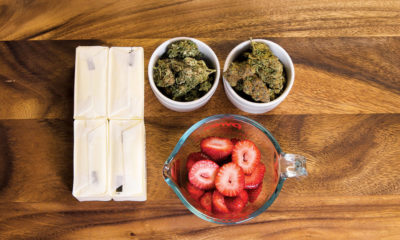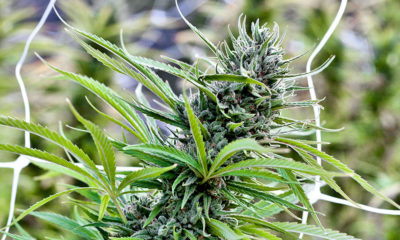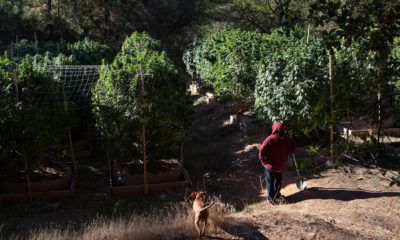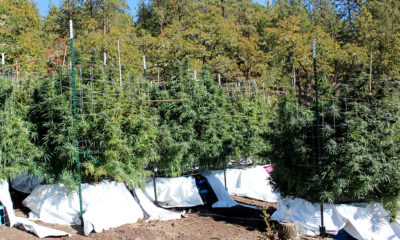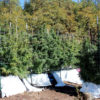
Cultivation
THC Extraction: How to Turn Trim to Profits
In order to make money in the cannabis industry, it’s important to learn about the intricacies of the business.
Growers, tenders, trimmers, producers and distributors all take different risks, skillsets and roles. Working with cannabis insiders operating on both sides of the law gives insight into the process of cultivating these plants and turning them into profit. Utilizing trim is one such way.
The strain of cannabis grown doesn’t matter as much as the process you use to grow, harvest and prep the product for sale. Fruit and vegetables bought in a store aren’t just ripped from the ground and sold as is – they’re gussied up and made presentable. Cannabis is no different.
The types of nugs most dispensaries look for are indoor grown nuggets. A proper farmer can trim an outdoor nug to look like an indoor nug, but it takes the careful removal of all water leaves and stems from the product.
The trimming process is the variable that determines the value of your cannabis. A haphazard trim shaves valuable crystals off the buds while leaving crow’s feet and stickers in the product. To inspect a dispensary’s inventory quality, pick up a nug and rotate it to check the trim job.
A properly-harvested and trimmed plant leaves a large amount of trimmings. These are the water leaves, sugar leaves and unformed nugs left on the stems and stocks that have been harvested for nugs. This product now needs to be trimmed again and sorted through, stem-by-stem, in order to clean the stems and stalks out, which can be discarded.
Water leaves (leaves without crystals) are often left in the trim to be extracted. Although THC isn’t extracted from them, the leaves contain a variety of terpenes and other valuable nutrients that round out the plant’s capabilities and the extract’s flavor. By the time the trim is ready to blow through an extractor, what will be left will look like the trimmings from mowing the lawn. The extraction from this will be as good as anything one would get from extracting nuggets.
Extracting Product From Trim
Extraction can be accomplished in several ways. There are open-and closed-loop solvent (butane, propane, etc) systems, CO2, alcohol, dry ice, and even ice water extraction systems. The system used is dependent upon what is available and what the extractor is competent enough to use, although if a solvent is used, know that a safe closed-loop system could cost between $50,000 and $200,000. An open-loop system can explode because of inherent impurities in the solvent.
When using a solvent system, be careful not to overload the amount of product blowing through the tubes. Processing 10-20 lbs of trim should take at least 24 hours on a closed-loop solvent system and up to 10 days with alcohol and water distillation methods. The longer it sits, the more product is yielded.
A nug run is accomplished using nugs that wouldn’t make it to retail. Don’t shove the biggest head nugs (a.k.a – colas) into the machine. That’s sellable product – juices and jams aren’t made with the choicest produce. Instead, run nugs smaller than a thumbnail.

PHOTO Ed Rosenthal
Once extracted, lay the gooey liquid out on wax paper in pans. To make honeycomb or wax, stirring the extract rapidly adds air, which whips the product, making it appear bigger, even though it has the same weight.
Extracts made from solvents are considered purer than those made without. A concentrate made with solvent has a higher THC or CBD content with 70 to 90 percent contents. Wax made from these concentrates will be an eggshell color and very crumbly. These are best dabbed in a vape pen.
Extracts made without solvents tend to be sold as bubble hash, as they’re basically just kief mud. These will often be much darker in color, although still provide a great high, and many people prefer the flavor of hash, which is popular in various parts of the world.
The extract will then need time to set. The sludge will bubble as gasses from the solvent, alcohol or water are released from the bubbles within. Wait at least 48 hours for the concentrate to cure before attempting to smoke it. Otherwise, there may be serious health risks, including damaging your throat and lungs or explosion because dab rigs use high heat.
Wax is known to be the least consistent concentrate and over time it gets drier and harder to deal with. Those lighter crumbly waxes may look good, but they can be difficult to work with — not to mention how easy it is to lose a lot of crumbs. Shatter is marketed as the most stable concentrate, but it, too, loses its consistency over time. Shatter is similar to a Jolly Rancher, which can be either chewy or hard, depending on how long it’s been sitting in the sun.
The concentrate many aim to duplicate is a light honey-like amber, which has maximum flavor and effect (usually around 60 to 70 percent THC/CBD content), and retains the consistency of Play-Dough throughout its lifecycle. This consistency makes dabbing easy with both a vape pen and dab rig.





